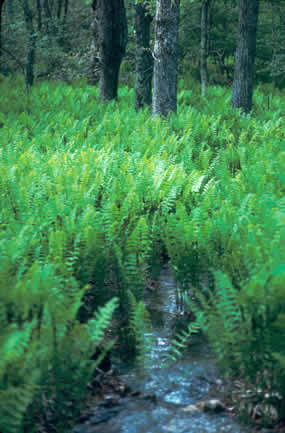 |
| Interrupted Fern (Osmunda claytoniana) |
 |
Ferns can be discovered in almost any habitat within Shenandoah National Park. These primitive vascular plants reproduce through spores instead of seeds and can live anywhere from the rich moist soil around a spring to the dry crevice in a cliff face. The Park supports approximately 60 species of fern and an additional 20 species of related spore producing plants (fern allies) such as club mosses and horsetails.
Shenandoah’s mid-Atlantic location straddles the ranges of both northern and southern adapted species creating relatively high fern diversity. Some species in the park such as the oak fern (Gymnocarpium dryopteris), and the rusty cliff fern (Woodsia ilvensis) are adapted to high elevation habitats characteristic of more northern forests. Other species such as the Virginia chain fern (Woodwardia virginica), and the hairy lip fern (Cheilanthes lanosa) are more characteristic of the southern states.
Many people associate ferns with a highly divided leaf shape, but not all ferns look this way. Ferns can grow in a myriad of shapes and sizes. Shenandoah supports not only the common adder’s tongue fern (Ophioglossum vulgatum) with its simple un-divided leaf measuring only six centimeters (about three inches) tall when full grown, all the way up to species like the royal fern (Osmunda regalis) with its large divided leaves that can grow up to 180 centimeters (over six feet) tall.
Some of the largest displays of ferns in the Park can be seen along the northern section of Skyline drive near Elkwallow wayside. Here you can see hay scented fern (Dennstaedtia punctilobula) growing throughout the understory for many miles. Wetland ferns such as the meter (three foot) tall interrupted fern (Osmunda claytoniana) can be viewed along the Limberlost trail, and at the base of the Stonyman nature trail.
Related Information
Useful references on for ferns in Shenandoah National Park include:
Lellinger, D.B. 1985. Ferns and Fern-Allies of the United States and Canada. Smithsonian Institution Press, Washington, DC.
Mazzeo, P.M. 1981. Ferns and Fern Allies of Shenandoah National Park. Shenandoah Natural History Association, Luray, Virginia.
One website that providea photographs and helpful biological information about ferns is:
The American Fern Society
Listing of these websites does not and is not intended to imply endorsement by the National Park Service of commercial services or products associated with the sites.
| 





